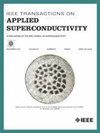Study of Resistive SFCL for Stability Increase of BTB-VSC-HVDC System Based on Virtual Synchronous Generator Control Strategy
IF 1.7
3区 物理与天体物理
Q3 ENGINEERING, ELECTRICAL & ELECTRONIC
引用次数: 0
Abstract
For a back-to-back voltage-source-converter HVDC (BTB-VSC-HVDC) system using virtual synchronous generator (VSG) control, it enables more adaptable voltage and frequency support for the main network. In this article, the investigation of the resistive superconducting fault current limiter (R-SFCL) for increasing the BTB-VSC-HVDC's stability under faults is carried out. Firstly, the topological structure and control scheme of the BTB-VSC-HVDC are expatiated. Then, the influence mechanism of cooperating with the R-SFCL and the VSG controller on the power angle stability (PAS) is explored from an energy balance perspective, where the R-SFCL's effects on boosting the VSC's low-voltage ride-through (LVRT) functionality are considered. In light of the MATLAB platform, a detailed digital model of ±420 kV BTB-VSC-HVDC incorporating R-SFCL is created, and the approach validation of coordinating the R-SFCL as well as the VSG controller to address different fault scenarios is implemented. The simulation findings confirm the R-SFCL's efficacy in dissipating the imbalanced power in the BTB-VSC-HVDC and lifting the LVRT behaviors of the VSC. As the efficient coordination of the R-SFCL and the VSG controller in moderate and serious faults, not only the AC voltage drop is ameliorated, but also the PAS of the demonstrated system is visibly increased.基于虚拟同步发电机控制策略的用于提高 BTB-VSC-HVDC 系统稳定性的电阻式 SFCL 研究
对于采用虚拟同步发电机(VSG)控制的背靠背电压源-变换器高压直流(BTB-VSC-HVDC)系统而言,它能为主网提供更具适应性的电压和频率支持。本文对电阻超导故障限流器(R-SFCL)进行了研究,以提高 BTB-VSC-HVDC 在故障下的稳定性。首先,阐述了 BTB-VSC-HVDC 的拓扑结构和控制方案。然后,从能量平衡的角度探讨了 R-SFCL 与 VSG 控制器配合对功率角稳定性(PAS)的影响机制,其中考虑了 R-SFCL 对 VSC 低电压穿越(LVRT)功能的提升作用。根据 MATLAB 平台,创建了包含 R-SFCL 的 ±420 kV BTB-VSC-HVDC 的详细数字模型,并对 R-SFCL 和 VSG 控制器的协调方法进行了验证,以应对不同的故障情况。仿真结果证实了 R-SFCL 在消除 BTB-VSC-HVDC 中的不平衡功率和改善 VSC 的低电压穿越行为方面的功效。由于 R-SFCL 和 VSG 控制器在中度和严重故障中的有效配合,不仅改善了交流压降,还明显提高了演示系统的 PAS。
本文章由计算机程序翻译,如有差异,请以英文原文为准。
求助全文
约1分钟内获得全文
求助全文
来源期刊

IEEE Transactions on Applied Superconductivity
工程技术-工程:电子与电气
CiteScore
3.50
自引率
33.30%
发文量
650
审稿时长
2.3 months
期刊介绍:
IEEE Transactions on Applied Superconductivity (TAS) contains articles on the applications of superconductivity and other relevant technology. Electronic applications include analog and digital circuits employing thin films and active devices such as Josephson junctions. Large scale applications include magnets for power applications such as motors and generators, for magnetic resonance, for accelerators, and cable applications such as power transmission.
 求助内容:
求助内容: 应助结果提醒方式:
应助结果提醒方式:


